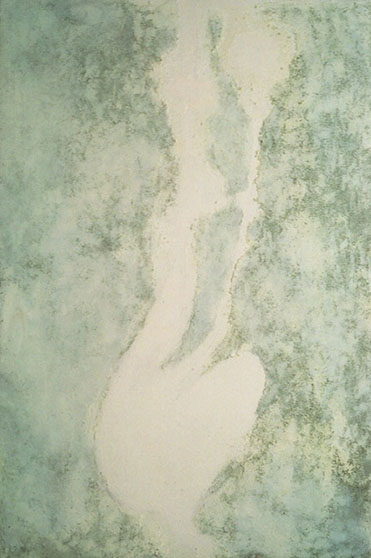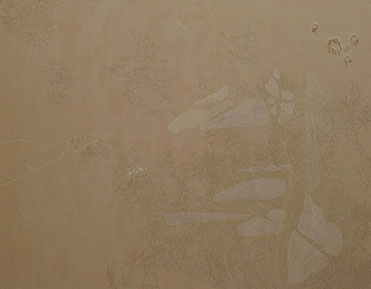An interview with Valentina Carini
By Eleonora Di Erasmo
V. Carini: At Central Saint Martins, in London, where I studied painting, we had to explain our works on a regular basis. I remember feeling it like a stretch, since I actually do not love talking about my works very much, I would rather let them speak for me. Words, I believe, cannot express what a piece of artwork has to convey. Making art is my way of expressing myself.
Eleonora Di Erasmo: Tell me about your artistic background. How did you approach painting?
V. Carini: I have always felt the need of holding a pencil in my hand and draw, but I could not attend Art School.
 It all started when I went to live in London and was admitted to Central Saint Martins College of Art and Design. Before entering college, during my BTEC Art Foundation Studies, I used to make paintings which were totally different from the ones I would later on conceive. I explored the world of drawing and colour; the iconography of my paintings was very strong, as the colours were. I used colour in a graphic manner and I maybe got that from my working experience in television.
It all started when I went to live in London and was admitted to Central Saint Martins College of Art and Design. Before entering college, during my BTEC Art Foundation Studies, I used to make paintings which were totally different from the ones I would later on conceive. I explored the world of drawing and colour; the iconography of my paintings was very strong, as the colours were. I used colour in a graphic manner and I maybe got that from my working experience in television.
That research then led me to paint trees. It was all born from my desire to try and make human inner life emerge through my works.
The first painting I made [on the left: untitled, 2002. Oil and marble dust on canvas, 145x90cm / 57×35.4in] depicts a crouching woman from whom flowers raising towards the sky come out in the place of her head and arms. I remember drawing inspiration from one of Paul Klee’s drawings, seen at an exhibition at the Hayward Gallery in London; on it a woman was depicted from whose womb flowers came out.
Those flowers trasformed in me into ramifications in which I see the bonds uniting human beings one another, as if there was an aura, a sort of energy connecting us all. This energy turned into branches.
E. Di Erasmo: From the initial representation of trees in your first works, you have gradually come to a sort of abstraction of an image of a tree. The branches have turned into small spots, traces of a map that at one point seem to build up and at some other seem to thin out. How has this transition happened?
V. Carini: Antoine De Saint-Exupà©ry, in “The Little Prince”, says: “what is essential is invisible to the eyes”. My greatest desire would be to try and express in my works what is essential, but without showing it. I would like to represent invisibility, yearning which I know being impossible to fulfil. The latest painting I painted has come of a long research towards essentiality [below left: Untitled, 2006. Pencil, watercolour, acrylic and sewing thread on canvas – 140x180cm]
I would like to lay bare our innermost self, give tangible shape to our essence, even if I know that it is something indefinite. It is, perhaps, an impossible piece of research.
E. Di Erasmo: In your first paintings you aimed at highlighting the parts that were full, the branches. Later on, by abstracting the shapes, you have instead come to make the empty spaces surface on the canvas.
V. Carini: It is true, revealing emptiness was closer to my research on invisibility and essence. I try to represent something that is not there, through, for instance, even the use of chalk, which seems to first appear and then disappear. I am attempting to deepen my research also through materials.
E. Di Erasmo: In this research on invisibility, does also the use of soft colours have a fundamental role?
V. Carini: I love colours. What has puzzled me during my research is that I have chosen to use some non-colours on the canvas, despite having always had a strong sense of colour. However, the invisible elements lying within us are colourless; I therefore strive to find some shades of transparency, transparent white, white playing with the pencil, with the shapes, with the canvas itself.
 E. Di Erasmo: One important characteristic which seems to emerge from your canvas is slowness, not only of your working method but also of the way your works are perceived by the viewer.
E. Di Erasmo: One important characteristic which seems to emerge from your canvas is slowness, not only of your working method but also of the way your works are perceived by the viewer.
V. Carini: When I end a painting it is as if I did not feel it as mine anylonger; I look at it as if I did not know where it comes from; hence my choice of leaving my works untitled. In reality, the painting becomes of whom is looking at it, a bit like the perception of reality which depends what side one looks at it from.
What interests me most is to be able to observe the small things rather than the big ones; this is the reason why who is observing my paintings has to be more attentive and slower.
I must not be in a hurry either, when realizing my works. The use of sewing thread as a means of expression, for instance, refers to the image of a slow gesture in space: I must allow the needle to pass from one side to the other of the canvas, pull the thread and repeat the same movement hundreds of times. It is about a sort of catartic gesture. I long for slowness and now that we are used to extreme speed, this is for me great attainment.
E. Di Erasmo: The lines and spots the canvas is disseminated with almost seem to emerge from its same weave and living a life of their own.
V. Carini: Each line can generate an idea for tracing the subsequent one. There is not any preparation in my paintings; a painting is born and is created on the canvas itself. I begin a painting but never know how it will end.
Eleonora Di Erasmo, May, 2007